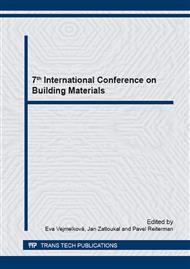p.33
p.39
p.43
p.49
p.55
p.61
p.65
p.71
p.77
Ceramic Waste Powder as an Active Pozzolanic Material for Cement Based Composites
Abstract:
Parameters of cement pastes with ceramic powder as partial Portland cement replacement up to 40 mass% are presented in the paper. Ceramic powder belongs to the pozzolanic materials. Utilization of pozzolanic materials is accompanied by lower request on energy needed for Portland clinker calcination which generally results in lower production costs of blended binder and lower CO2 emissions. The ceramic powder is used in cement based pastes composition in amount of 8, 16, 24, 32, and 40 mass% of cement. For the studied ceramic powder, chemical composition is measured by X-Ray Fluorescence. The particle size distribution of ceramics is accessed on laser diffraction principle. Bulk density, matrix density, and total open porosity are measured for 28 days cured paste samples. The obtained results demonstrate that ceramic powder has potential to replace a part of Portland cement in composition of cement based composites.
Info:
Periodical:
Pages:
55-59
Citation:
Online since:
July 2015
Authors:
Price:
Сopyright:
© 2015 Trans Tech Publications Ltd. All Rights Reserved
Share:
Citation:


